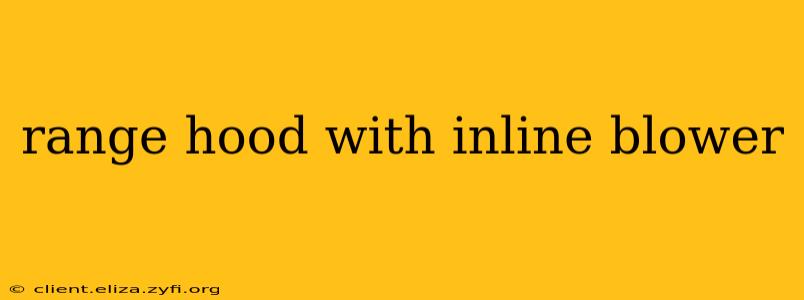Choosing the right range hood is crucial for maintaining a clean and healthy kitchen environment. While many range hoods have built-in blowers, a growing number of homeowners are opting for range hoods with inline blowers. This guide will explore the benefits, drawbacks, and considerations when choosing a range hood with an inline blower.
What is an Inline Blower for a Range Hood?
An inline blower is a separate unit that's installed in the ductwork, usually in the attic or outside the house. It's different from a traditional range hood with a built-in blower, where the fan is housed within the hood itself. The inline blower sits remotely, connecting to the hood via the ductwork. This arrangement offers several advantages over traditional designs.
Benefits of a Range Hood with an Inline Blower
-
Quieter Operation: Because the blower is located away from the kitchen, noise levels are significantly reduced. This makes for a more pleasant cooking experience, especially during longer cooking sessions.
-
Increased Suction Power: Inline blowers often boast greater CFM (cubic feet per minute) ratings compared to built-in blower systems. This translates to more effective ventilation, crucial for removing smoke, grease, and odors efficiently.
-
Compact Hood Design: The absence of a bulky internal blower allows for sleeker and more compact hood designs. This opens up possibilities for aesthetically pleasing hoods that complement various kitchen styles.
-
Flexibility in Ductwork Placement: The remote location of the blower offers greater flexibility in routing ductwork, making installation easier in various house layouts. This is especially beneficial in older homes or those with unconventional ductwork configurations.
-
Easier Maintenance: Accessing and maintaining the blower is often simpler, as it is not nestled inside the hood itself.
Drawbacks of a Range Hood with an Inline Blower
-
Higher Initial Cost: Inline blower systems typically have a higher upfront cost than range hoods with built-in blowers.
-
Installation Complexity: The installation process for an inline system is often more complex and may require professional help, potentially adding to the overall expense.
-
Additional Space Requirements: You'll need space in your attic or outside your home to house the inline blower unit.
-
Potential for Noise in Other Areas: While the kitchen is quieter, the noise might be more noticeable in the area where the inline blower is installed (e.g., attic).
What CFM Do I Need for My Range Hood?
The necessary CFM (cubic feet per minute) rating depends on the size of your cooktop and how often you cook. Consult the manufacturer's recommendations and consider the following:
-
Cooktop Size: Larger cooktops require higher CFM ratings for adequate ventilation.
-
Cooking Habits: Frequent and intense cooking necessitates a higher CFM rating to effectively remove grease and odors.
-
Kitchen Size: Larger kitchens may require a higher CFM rating to ensure effective ventilation of the entire space.
It's crucial to calculate your specific needs rather than relying solely on general guidelines.
Can I Install a Range Hood with an Inline Blower Myself?
While technically possible for some DIY enthusiasts, installing an inline blower system is often more complex than installing a traditional range hood. It requires careful planning, precise measurements, and a good understanding of electrical and ventilation systems. Unless you're experienced in such installations, it's highly recommended to hire a qualified professional.
How Much Does a Range Hood with an Inline Blower Cost?
The cost varies significantly depending on several factors such as brand, features, CFM rating, and size. Expect a price range considerably higher than traditional range hoods, typically starting at several hundred dollars and potentially exceeding several thousand for high-end models.
How to Choose the Right Range Hood with an Inline Blower
Consider these factors when making your selection:
- CFM Rating: Choose a rating appropriate for your cooktop size and cooking habits.
- Noise Level: Look for a system with a low noise level, even at high fan speeds.
- Size and Style: Choose a hood that complements your kitchen's aesthetics.
- Features: Consider features like lighting, filters, and control options.
- Installation: Assess the feasibility of installation based on your home's layout and ductwork.
By carefully weighing the benefits and drawbacks and considering your specific needs, you can choose a range hood with an inline blower that enhances your kitchen's functionality and aesthetic appeal.
